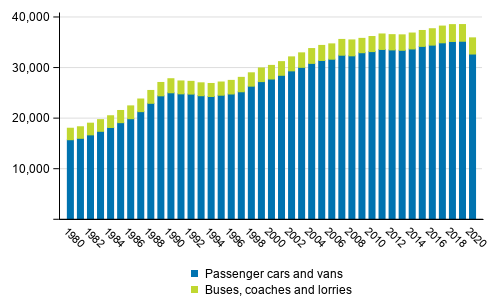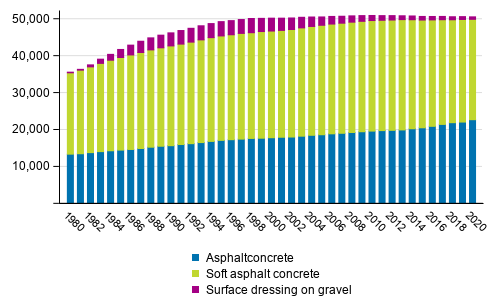Published: 15 April 2021
Number of car kilometres decreased by four per cent in 2020
In 2020, the total number of kilometres driven with passenger cars was 39,092 million car kilometres, i.e. four per cent fewer as in the year before. The kilometres for heavy vehicles decreased by four per cent last year. The traffic performance on highways decreased from the previous year. Last year, there were more new pavement projects than in 2019.
The traffic performance on highways (mill. vehicle-km) in 1980–2020

Total traffic performance
In 2020, the total number of kilometres driven with all vehicles, or the traffic performance, on the highway and street networks of Mainland Finland 1) amounted to 48,543 million car kilometres in total, which was four per cent lower than in 2019. The total number of kilometres driven with passenger cars was 39,092 million car kilometres, i.e. four per cent less than in the year before. The total performance of vans decreased by one per cent from the previous year.
The kilometres for heavy vehicles decreased in 2020. The traffic performance of lorries totalled 3,261 million car kilometres, which was 2.4 per cent down on the year before. Altogether 523 million kilometres were driven with buses, i.e. the traffic performance of buses decreased by 13 per cent from the previous year. The share of heavy vehicles was 8 per cent of all traffic.
Traffic performance on highways
In 2020, the traffic performance on highways 2) decreased from the previous year. In 2020, the total traffic performance on highways for light vehicles, that is, passenger cars and vans, decreased by seven per cent compared to the traffic performance on highways in 2019. The traffic performance on highways for heavy vehicles decreased by three per cent compared to 2019. The share of the highway network of total performance is 74 per cent and the share of street performance is 26 per cent.
In 2020, the highway performance of passenger cars decreased by 7.5 per cent and the highway performance of vans by 4.5 per cent from 2019. The highway performance of lorries decreased by 1.7 per cent. The number of highway kilometres of buses declined by 13 per cent.
Fiftyone per cent of highway traffic was on class I main roads in 2020. Fourteen per cent of the traffic performance was on class II main roads, 19 per cent on regional roads and 16 per cent on connecting roads. The traffic performance of class I main roads decreased 9 per cent from the previous year, traffic on class II main roads decreased by 6 per cent and regional and connecting roads decreased by about three per cent. Altogether 30 per cent of the traffic performance took place in the area of the ELY centre of Uusimaa, that is, on the highways of the regions of Uusimaa, Kanta-Häme and Päijät-Häme.
In 2020, an average of 1,265 vehicles per day travelled on Finnish highways. Most vehicles travelled in the region of Uusimaa, or 4,575 vehicles per day on average. In the region of Kanta-Häme an average of 1,843 vehicles per day and in Päijät-Häme an average of 1,712 vehicles per day were recorded. The region of Kainuu had the least traffic, 412 vehicles per day on average.
Table 1. Traffic performance (mill. vehicle-km) on the Finnish highway and street network by vehicle category in 2020
| Vehicle class | Highways | Streets and private roads | Total |
| Cars total | 35,971 | 12,572 | 48,543 |
| Passenger car | 28,613 | 10,479 | 39,092 |
| Van | 4,160 | 1,507 | 5,667 |
| Light vehicles total | 32,773 | 11,986 | 44,759 |
| Bus and coach | 358 | 165 | 523 |
| Truck | 2,840 | 421 | 3,261 |
| Heavy vehicles total | 3,198 | 586 | 3,784 |
Passenger traffic performance
In 2020, the passenger traffic performance of passenger cars 3) was 64.1 billion passenger-kilometres in total, i.e. four per cent less than in the year before. In 2020, the passenger traffic performance of bus transport was 6.8 billion passenger-kilometres in total. The passenger traffic performance of bus transport fell by 14 per cent from the previous year.
Finnish highways in 2020
At the end of 2020, the length of highways in Mainland Finland totalled 77,908 km, 17 km less than one year earlier. Of this, 50,973 km were connecting roads, 13,484 km regional roads, 8,593 km class I main roads and 4,858 km class II main roads. In addition, 1,392 km were ramps, 46 km roundabouts and 62 km ferry routes. Twenty-one per cent of highways are in North Savo, 16 per cent in North Ostrobothnia and Kainuu and 12 per cent in Lapland. These and the examinations by region mentioned below have been made according to the division of traffic by regional ELY centre. 4)
Of highways, 933 km were motorways and 136 km semi-motorways. The number of motorways has grown evenly over the years – in twenty years their number has almost doubled. There were altogether 6,062 km of paths for cyclists and pedestrians on highways. Nineteen per cent of the paths were in Uusimaa, 15 per cent in Southwest Finland and 13 per cent in South Ostrobothnia.
Highway pavements
Thirty-six per cent of highways are oil gravel roads (or corresponding), 35 per cent gravel roads and 29 per cent permanent pavement roads. The area of North Savo has the highest number of gravel roads, around one-half of the roads are gravel roads, while over one-half of the road network in Uusimaa is permanently paved. The highest number of oil gravel roads is found in North Ostrobothnia, where 41 per cent of the road network consists of oil gravel roads. At the end of 2020, there were 50,647 kilometres of permanent pavement roads, i.e. 65 per cent of all highways in Mainland Finland. Almost all pavements were asphalt concrete or soft asphalt concrete. There were only 674 kilometres of surface-dressed gravel roads at the end of 2020. New pavement projects covered 3,686 km
Pavements on highways in 1980–2020

Other data
The length of lit-up highway sections was 12,882 km, eight km more than in the previous year. Of speed limits, 80 km/h is the most common covering 51,555 km, which is 164 km more than in the previous year. Areas with —50 km/h increased most, by a little less than two per cent.
When it comes to the width of roads, the share of dual carriageway highways had increased most from the previous year, by around three per cent, and second most that of roads with a width of eleven metres, by around one per cent.
1) The total performance of road traffic is based on data on odometer readings of Finnish vehicles saved in Traficom’s transport register at the time of inspection and the performance data produced from them by Statistics Finland. The results have been statistically inflated to correspond to the total performance of the vehicle category in question, i.e. passenger car, van, lorry and bus.
2) The traffic performance on highways is based on the results of the Finnish Transport Infrastructure Agency’s highway traffic calculations.
3) Passenger traffic performance is calculated from the traffic performance of vehicles by using a coefficient describing the average number of persons travelling in a vehicle.
4) The operating area of the Centre for Economic Development, Transport and the Environment of Uusimaa in terms of traffic and infrastructure covers the regions of Uusimaa, Kanta-Häme and Päijät-Häme. The operating area of Centre for Economic Development, Transport and the Environment of Southwest Finland in terms of traffic and infrastructure covers the regions of Southwest Finland and Satakunta. The operating area of the Centre for Economic Development, Transport and the Environment of Pirkanmaa in terms of traffic and infrastructure covers the region of Pirkanmaa. The operating area of the Centre for Economic Development, Transport and the Environment of Southeast Finland in terms of traffic and infrastructure covers the regions of Kymenlaakso and South Karelia. The operating area of the Centre for Economic Development, Transport and the Environment of North Savo in terms of traffic and infrastructure covers the regions of North Savo, South Savo and North Karelia. The operating area of the Centre for Economic Development, Transport and the Environment of Central Finland in terms of traffic and infrastructure covers the region of Central Finland. The operating area of the Centre for Economic Development, Transport and the Environment of South Ostrobothnia in terms of traffic and infrastructure covers the regions of South Ostrobothnia, Ostrobothnia and Central Ostrobothnia. The operating area of the Centre for Economic Development, Transport and the Environment of North Ostrobothnia in terms of traffic and infrastructure covers the regions of North Ostrobothnia and Kainuu. The operating area of the Centre for Economic Development, Transport and the Environment of Lapland in terms of traffic and infrastructure covers the region of Lapland.
Source: Transport and tourism, Statistics Finland
Inquiries: Sami Lahtinen 029 551 3207, Ville Keränen 029 551 0735, Olli Kajava 029 551 3531, sami.lahtinen@stat.fi
Head of Department in charge: Hannele Orjala
Publication in pdf-format (232.3 kB)
- Tables
-
Tables in databases
Pick the data you need into tables, view the data as graphs, or download the data for your use.
Updated 15.04.2021
Official Statistics of Finland (OSF):
Finnish Road Statistics [e-publication].
ISSN=2670-3386. 2020. Helsinki: Statistics Finland [referred: 19.4.2025].
Access method: http://stat.fi/til/tiet/2020/tiet_2020_2021-04-15_tie_001_en.html

